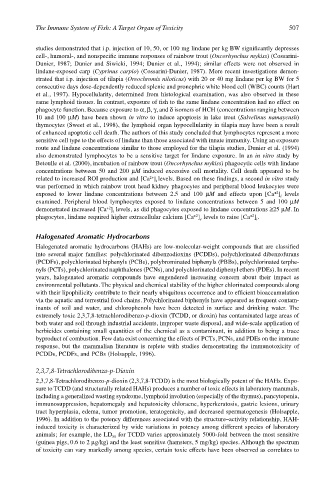Page 527 - The Toxicology of Fishes
P. 527
The Immune System of Fish: A Target Organ of Toxicity 507
studies demonstrated that i.p. injection of 10, 50, or 100 mg lindane per kg BW significantly depresses
cell-, humoral-, and nonspecific immune responses of rainbow trout (Oncorhynchus mykiss) (Cossarini-
Dunier, 1987; Dunier and Siwicki, 1994; Dunier et al., 1994); similar effects were not observed in
lindane-exposed carp (Cyprinus carpio) (Cossarini-Dunier, 1987). More recent investigations demon-
strated that i.p. injection of tilapia (Oreochromis niloticus) with 20 or 40 mg lindane per kg BW for 5
consecutive days dose-dependently reduced splenic and pronephric white blood cell (WBC) counts (Hart
et al., 1997). Hypocellularity, determined from histological examination, was also observed in these
same lymphoid tissues. In contrast, exposure of fish to the same lindane concentration had no effect on
phagocyte function. Because exposure to α, β, γ, and δ isomers of HCH (concentrations ranging between
10 and 100 µM) have been shown in vitro to induce apoptosis in lake trout (Salvelinus namaycush)
thymocytes (Sweet et al., 1998), the lymphoid organ hypocellularity in tilapia may have been a result
of enhanced apoptotic cell death. The authors of this study concluded that lymphocytes represent a more
sensitive cell type to the effects of lindane than those associated with innate immunity. Using an exposure
route and lindane concentrations similar to those employed for the tilapia studies, Dunier et al. (1994)
also demonstrated lymphocytes to be a sensitive target for lindane exposure. In an in vitro study by
Betoulle et al. (2000), incubation of rainbow trout (Oncorhynchus mykiss) phagocytic cells with lindane
concentrations between 50 and 200 µM induced excessive cell mortality. Cell death appeared to be
2+
related to increased ROI production and [Ca ] levels. Based on these findings, a second in vitro study
i
was performed in which rainbow trout head kidney phagocytes and peripheral blood leukocytes were
+2
exposed to lower lindane concentrations between 2.5 and 100 µM and effects upon [Ca ] levels
i
examined. Peripheral blood lymphocytes exposed to lindane concentrations between 5 and 100 µM
+2
demonstrated increased [Ca ] levels, as did phagocytes exposed to lindane concentrations ≥25 µM. In
i
+2
+2
phagocytes, lindane required higher extracellular calcium [Ca ] levels to raise [Ca ] . i
e
Halogenated Aromatic Hydrocarbons
Halogenated aromatic hydrocarbons (HAHs) are low-molecular-weight compounds that are classified
into several major families: polychlorinated dibenzodioxins (PCDDs), polychlorinated dibenzofurans
(PCDFs), polychlorinated biphenyls (PCBs), polybrominated biphenyls (PBBs), polychlorinated terphe-
nyls (PCTs), polychlorinated naphthalenes (PCNs), and polychlorinated diphenyl ethers (PDEs). In recent
years, halogenated aromatic compounds have engendered increasing concern about their impact as
environmental pollutants. The physical and chemical stability of the higher chlorinated compounds along
with their lipophilicity contribute to their nearly ubiquitous occurrence and to efficient bioaccumulation
via the aquatic and terrestrial food chains. Polychlorinated biphenyls have appeared as frequent contam-
inants of soil and water, and chlorophenols have been detected in surface and drinking water. The
extremely toxic 2,3,7,8-tetrachlorodibenzo-p-dioxin (TCDD, or dioxin) has contaminated large areas of
both water and soil through industrial accidents, improper waste disposal, and wide-scale application of
herbicides containing small quantities of the chemical as a contaminant, in addition to being a trace
byproduct of combustion. Few data exist concerning the effects of PCTs, PCNs, and PDEs on the immune
response, but the mammalian literature is replete with studies demonstrating the immunotoxicity of
PCDDs, PCDFs, and PCBs (Holsapple, 1996).
2,3,7,8-Tetrachlorodibenzo-p-Dioxin
2,3,7,8-Tetrachlorodibenzo-p-dioxin (2,3,7,8-TCDD) is the most biologically potent of the HAHs. Expo-
sure to TCDD (and structurally related HAHs) produces a number of toxic effects in laboratory mammals,
including a generalized wasting syndrome, lymphoid involution (especially of the thymus), pancytopenia,
immunosuppression, hepatomegaly and hepatoxicity chloracne, hyperkeratosis, gastric lesions, urinary
tract hyperplasia, edema, tumor promotion, teratogenicity, and decreased spermatogenesis (Holsapple,
1996). In addition to the potency differences associated with the structure–activity relationship, HAH-
induced toxicity is characterized by wide variations in potency among different species of laboratory
animals; for example, the LD for TCDD varies approximately 5000-fold between the most sensitive
50
(guinea pigs, 0.6 to 2 µg/kg) and the least sensitive (hamsters, 5 mg/kg) species. Although the spectrum
of toxicity can vary markedly among species, certain toxic effects have been observed as correlates to

